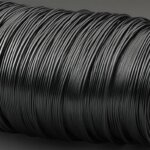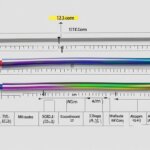Table of Contents
Fiber optic cables have revolutionized high-speed data transmission, offering numerous advantages over traditional wiring systems. Whether you’re streaming videos, gaming, or working remotely, fiber optic cables play a crucial role in delivering fast and reliable internet connections.
So, what exactly are fiber optic cables? They are the backbone of internet services like Verizon Fios home internet, enabling the transmission of information as pulses of light through strands of fiber made of glass or plastic over long distances.
These optical fibers, which are incredibly thin (about the diameter of a strand of human hair), are bundled together to form a fiber-optic cable. This technology allows fiber optics to transmit more data over longer distances and at faster speeds compared to traditional electrical cables.
Unlike electrical cables that use electrical signals to transmit data, fiber-optic cables transfer data signals in the form of light, allowing them to travel significantly faster and with less interference. This means fiber optic cables can offer significantly faster upload and download speeds, ample bandwidth for multiple devices, and a reliable connection.
Types of Fiber Optic Cables
When it comes to fiber optic cables, there are various types available, each designed to suit specific needs and requirements. Understanding the different types of fiber optic cables will help you make informed decisions for your network infrastructure. Let’s explore the key types: singlemode, multimode, simplex, and duplex.
Singlemode vs Multimode Cables
Singlemode fiber optic cables are ideal for long-distance transmission, offering a single ray of light that travels directly down the core. These cables have a smaller core size (around 9 microns) and are optimized for transmitting data over longer distances with minimal signal loss. If your network infrastructure requires high-speed data transmission over extended distances, singlemode cables are the go-to choice.
On the other hand, multimode fiber optic cables have a larger core size (commonly between 50 and 62.5 microns) and enable the transmission of multiple rays of light simultaneously. These cables are more suitable for short-distance communication, such as within data centers, buildings, or campus environments. Multimode cables are popular due to their versatility and cost-effectiveness for shorter distances.
Simplex vs Duplex Cables
When it comes to the flow of data, fiber optic cables can be categorized as simplex or duplex. Simplex cables are used in applications where data needs to flow in only one direction. They have a single fiber strand within the cable and are commonly used in applications such as video transmission or in situations where communication is unidirectional.
On the other hand, duplex cables have two fiber strands within the cable, allowing data transmission in two directions. These cables are commonly used in applications where bidirectional communication is required, such as in networking and telecommunications. Duplex cables are often used for sending and receiving data simultaneously.
In addition to these basic types, there are other cable options available in the market. Active Optical Cables (AOC) are used to conduct light between components, making them suitable for short-range applications. Direct Attach Cables (DAC) are used to carry electrical current between components, offering a cost-effective solution for short-distance data transmission. These options provide flexibility in meeting specific networking needs.
Understanding the types of fiber optic cables is crucial in selecting the right solution for your network infrastructure. Whether you require long-distance high-speed data transmission or short-range bidirectional communication, choosing the appropriate fiber optic cable types ensures optimal performance and reliability.
Fiber Optic Cable Jacket Colors and Connectors
Fiber optic cable jacket colors play a crucial role in identifying different fiber types, cables, and connectors. Following the TIA-598 standard, specific colors are assigned to various fiber types. For instance, orange jackets are commonly used for multimode (50/125) cables, while yellow jackets indicate singlemode cables.
When it comes to making connections in fiber optic networks, fiber optic connectors are indispensable. There are various types of connectors, including LC, ST, and SC, each serving specific purposes. LC to LC connections, for example, are widely used for secure and reliable connections between two LC connectors.
To ensure efficient use of fiber optic cables, it’s essential to understand measurements and classifications. This includes knowledge of fiber optic cable sizes, OS (Optical Specification) and OM (Optical Multimode) classifications, and wire gauge. Being familiar with these details helps in proper installation and maintenance of fiber optic networks.
Fiber optic cables find applications in diverse fields, including telecommunications, LANs (Local Area Networks), industrial control systems, sensing technologies, power delivery for tasks like laser cutting and welding, and even illumination purposes. With their high performance and versatility, fiber optic cables continue to revolutionize the way we communicate and transfer data.
FAQ
What is fiber optics?
Fiber optics is the technology used by internet services such as Verizon Fios home internet to transmit information as pulses of light through strands of fiber made of glass or plastic over long distances.
How do fiber optics work?
Optical fibers are about the diameter of a strand of human hair and when bundled into a fiber-optic cable, they’re capable of transmitting more data over longer distances and faster than other mediums.
What are the advantages of fiber-optic cables?
Fiber-optic cables contain anywhere from a few to hundreds of optical fibers within a plastic casing and transfer data signals in the form of light, traveling significantly faster than those used in traditional electrical cables.
What are the different types of fiber-optic networks?
There are several types of fiber-optic networks, including Fiber to the Home (FTTH) or Fiber to the Premises (FTTP), Fiber to the Curb (FTTC), and Fiber to the Building (FTTB).
What are the benefits of fiber-optic internet?
Fiber-optic internet, such as Verizon Fios, offers significantly faster upload and download speeds, more bandwidth for multiple devices, and a reliable connection.
What are the types of fiber optic cables?
There are different types of fiber optic cables, such as singlemode and multimode cables.
What are singlemode fiber optic cables used for?
Singlemode fiber optic cables allow only one ray of light to be transmitted and are more suitable for longer distances.
What are multimode fiber optic cables used for?
Multimode fiber optic cables have several strands in a larger core, allowing multiple “rays” of light to be transmitted simultaneously, making them more suitable for shorter distances.
What are simplex and duplex fiber optic cables?
Simplex fiber optic cables are used when information or data only needs to flow in one direction, while duplex fiber optic cables have two strands and can carry information in two directions.
What are active optical cables (AOC) and direct attach cables (DAC)?
There are also different cable options such as active optical cables (AOC) that conduct light between components and direct attach cables (DAC) that carry electrical current between components.
How are fiber optic cable jacket colors used?
Fiber optic cable jacket colors are used to identify fibers, cables, and connectors. The TIA-598 standard recommends specific colors for different fiber types, such as orange for multimode (50/125) cables and yellow for singlemode cables.
What are fiber optic connectors used for?
Fiber optic connectors, such as LC, ST, and SC, are used to make connections in fiber optic networks. LC to LC connections, for example, provide a secure connection between two LC connectors.
What should I know about fiber optic measurements and classifications?
Understanding fiber optic measurements and classifications is essential, including fiber optic cable sizes, OS and OM classifications, and wire gauge.
What are the different applications of fiber optic cables?
Different applications of fiber optic cables include communications (telecommunications, LANs, industrial control systems), sensing (pressure, temperature, spectral information), power delivery (laser cutting, welding), and illumination.













